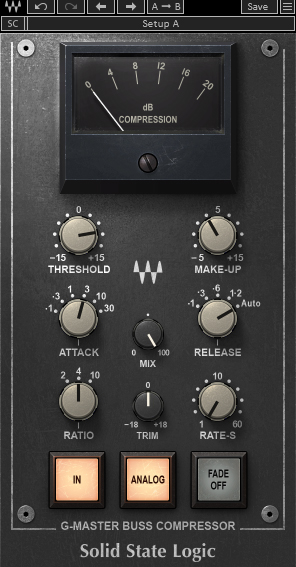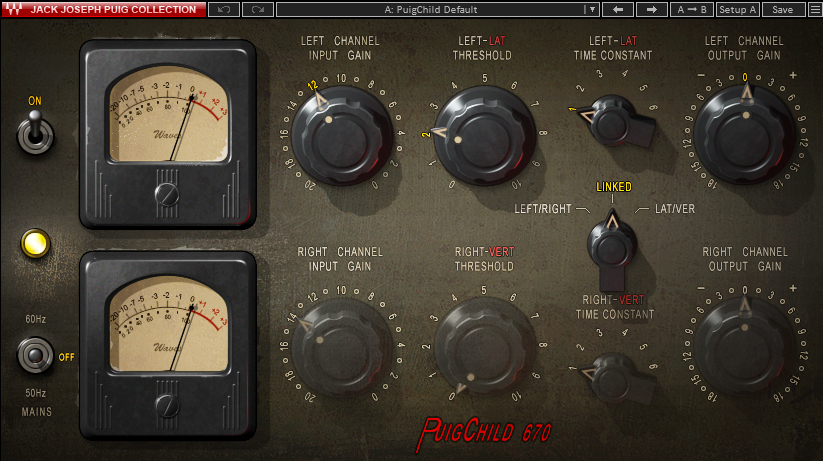There are 4 types of audio compressors which each have a place in the mixing and mastering world to get the most out of your audio.
Let’s cover each to give examples of what they are, how they work, and what to use them on. I’ll offer some options premium and free for each type to use in your mixes.
Types of Audio Compressors
FET Compressors

What is a FET Compressor
Let’s start with the FET or Field Effect Transistor compressor.
FET compressors use transistors to reduce gain and add some lovely coloring to the compressed audio. In fact, a lot of producers use the plugin in their signal chain without applying any actual compression, just to get its warmth.
The most famous example of a FET compressor is the 1967 Universal Audio 1176 which a lot of FET compressors mimic today.
It offers a fairly straightforward interface in an input to set your threshold, a few preset ratio buttons, and attack and release knobs to set practically instant timings. There’s also an output knob as well as a dry/wet dial.
When to Use a FET Compressor
A FET compressor is great on guitars, drums, and vocals. In particular it works really well to tame peaks.
As an example, I like to put one at the start of my signal chain on vocals with a ratio of 4:1 (the bottom button) to get roughly 5 db or so of gain reduction with a relatively fast attack and release time. Note that unlike most compressors, the higher numbers denote faster attack and release times.
From there you just adjust the output accordingly.
Most FET compressors feature the infamous “All” button above the lower ratio amounts. This results in an overdriven, almost saturation like effect on audio with a slower attack to let some transients through. This setting sounds great when used as parallel compression on a drum bus.
Best FET Compressor
I like varying it up between two options for my opinion on the best FET compressor plugin:
Arturia Comp FET-76 – This FET compressor (shown above) is modeled after the 1176 and has all of the relevant settings along with an attractive interface.
Waves CLA-76 – This is Waves’ FET compressor which is also modeled after the famed UA 1176. It was built with input from famed producer Chris Lord-Alge and as such has a number of his presets and other well known producers’ presets to help you dial in the sound you want fast.
Best Free FET Compressor
Analog Osession – FETISH – FETISH may be designed to look a bit different than Arturia or Waves’ 1176 modeled compressors, but everything you need is contained in this one FREE plugin.
Optical Compressors

What is an Optical Compressor
I’ll begin with optical compressors, also known as “opto compressors” for short. The term optical comes from the fact that this compressor literally generates light based on the input level of the signal. It uses the intensity of this light to determine how much to compress the signal.
More input signal means a brighter light which means more compression.
Optical compressors typically feature the most straightforward interfaces with the fewest options, making it hard to screw them up and easy to get the results you want.
There’s no set controls for the attack or release unlike on most any other type of compressor. This is because the attack and release are tied to and vary based on the amount of signal you’re feeding into the compressor.
The “knee” is gradual and as such the compression is much more transparent with an optical compressor.
Moreover and by virtue of how the opto compressor works, there’s not much in the way of “coloring” the tone like you get with tube or even transistor based compressors.
When to Use an Optical Compressor
Optical compressors work especially well on vocals in particular because they’re so effective in creating that extra bit of glue or constant presence in a vocal without hearing the compressor working (which goes back to its transparency).
As such I like to put one or even two in my vocal chain at different points to smooth out the signal after I’ve introduced a FET compressor to grab the peaks before them.
Best Optical Compressor
Waves CLA-2A – The optical compressor I find myself reaching for the most is the CLA-2A from Waves. It’s got a clean and simple interface, and once again like with the CLA-76, it’s got a handful of helpful presets for finding the sweet spot to compress your signal with fast.
Best Free Optical Compressor
Variety of Sound ThrillseekerLA – This is a solid 2A style optical compressor from VoS which won’t cost you a dime. They even just released a new version, so pick it up for free and try it on your vocals.
VCA Compressor

What Are VCA Compressors
VCA, or Voltage Controlled Amplifier compressors offer fast, low distortion, and transparent compression.
They are similar to optical compressors in that they won’t color your audio much. At the same time though they can operate much faster, making them effective for taming peaks on individual tracks or busses without altering the sonic quality of your audio.
When to Use VCA Compressors
As I just mentioned, VCA compressors are good for taming aggressive transients and peaks when that’s all you want.
Use it on an individual track or a bus which is still a bit too dynamic.
Best VCA Compressor
Waves SSL G Master Bus Compressor – When I need a bit of bus glue, I like the Waves SSL to tie things together. Based on the SSL 4000 G console and as the name suggests, this is great at or near the end of your master bus chain to provide that extra bit of unity to a mix that needs a touch more control and impact.
Free VCA Compressor
Most DAWs come with serviceable free VCA compressors. Ableton Live in particular comes with a solid VCA which is simply called the “Glue Compressor”.
Vari Mu Compressor

What as a Vari Mu Compressor
A Vari Mu compressor, also known as a variable mu compressor, is amongst the oldest forms of compression and is based on tubes. As such, a Vari Mu compressor imparts that warm and saturation sound of tubes to whatever you apply this compressor to.
Vari mu compressors work much slower than the snappier compressors I covered earlier. These aren’t form taming peaks but rather to soften a less dynamic track, bus, or even the master bus and bring some color to it at the same time.
When to Use a Vari Mu Compressor
As mentioned, variable mu compressors are slower, tube based compressors. They are best served when applied to more macro levels of your mix.
As such, try using one as a finishing touch on say a drum bus, vocal bus, or even the master fader itself.
While you’re sacrificing a little in the way of dynamics, you’re creating a more consistent, glued together sound in that track or bus (while giving it a bit of signature tube warmth).
Best Vari Mu Compressor
Waves PuigChild Compressor – The Fairchild 670 was the gold standard in its day and current Vari Mu compressors are STILL modeled after it. I typically reach for Waves’ PuigChild Compressor when I want some glue on my master bus. Sometimes I compare the results with the SSL G Master Buss Compressor and take the winner.
Free Vari Mu Compressor
Klanghelm MJUC Jr. – This is the free version of the senior version of this plugin. Offering less controls than its “older brother”, the simplicity of Jr.’s input and output makes it hard to mess up.
Types of Audio Compressors
- There are generally four categories which most compressors fall into.
- These compressors vary in how quickly they compress the audio and how much they add to or change the sound of the audio outside of the compression itself.
- FET compressors use small transistors to compress a signal and as such impart a bit of that analog sound in the process. They work well for catching peaks and warming up the sound on vocals, drums, guitars, etc.
- Optical compressors (or opto) turn audio signal into light to dictate how much to compress that signal. The more signal you feed, the greater the luminosity and more that signal gets compressed. In the absence of analog tubes (or the simulation of such in the case of a VST), the compressed audio is clean and transparent. Unless you really drive the input, you won’t hear the compressor working with an optp. This makes optical compressors perfect for vocals.
- VCA compressors are similar to FET compressors in their speed and are ideal for attenuating overly dynamic signals. The difference is that they don’t color the audio, so they’re ideal for bus compression, especially the master bus. At lower ratios, they make for some nice gentle glue-like compression on the master bus which many engineers regularly use.
- Vari Mu compressors are simple and classic tube based compressors. They compress relatively slowly and impart that warm tube sound, so they’re ideal when you want to introduce a little saturation like warmth to a track whether it’s an individual instrument or a bus.
So remember, there is a difference in the different types of audio compressors.
More importantly, knowing which to use in which setting can make a huge difference in your mixes moving forward.

Pingback: The Best Compressor for Vocals - Music Guy Mixing
Pingback: How to Use 1176 Compressor - Complete Guide - Music Guy Mixing
Pingback: Piano Compression Guide - How to Compress Piano - Music Guy Mixing
Pingback: Audio Compressor Settings Chart - The Best Settings - Music Guy Mixing
Pingback: 1176 All Buttons in Explained - What Does it Do? - Music Guy Mixing
Pingback: Audio Effects Explained - The Complete Guide - Music Guy Mixing
Pingback: How to Use Compression on Acoustic Guitar - The Perfect Settings - Music Guy Mixing
Pingback: The Best Audio Compressor for Mixing - Music Guy Mixing
Pingback: Optical Compressor - What It Is and How to Use It - Music Guy Mixing
Pingback: VCA Compressor - How to Use It in Your Mix - Music Guy Mixing
Pingback: FET Compressor - When and How to Use It in Your Mix - Music Guy Mixing
Pingback: Vari Mu Compressor - When to Use It in Your Mix - Music Guy Mixing